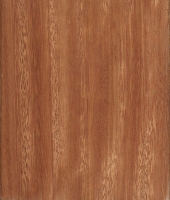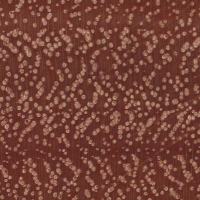 |
Common Name(s): Karri Scientific Name: Eucalyptus diversicolor Distribution: Southwestern Australia Tree Size: 150-200 ft (45-60 m) tall, 6-10 ft (1.8-3 m) trunk diameter Average Dried Weight: 55 lbs/ft3 (885 kg/m3) Specific Gravity (Basic, 12% MC): .74, .88 Janka Hardness: 2,030 lbf (9,030 N) Modulus of Rupture: 18,530 lbf/in2 (127.8 MPa) Elastic Modulus: 2,965,000 lbf/in2 (20.44 GPa) Crushing Strength: 10,380 lbf/in2 (71.6 MPa) Shrinkage: Radial: 7.8%, Tangential: 12.9%, Volumetric: 20.7%, T/R Ratio: 1.7 |
Color/Appearance: Heartwood is golden to reddish brown, sometimes with a orange or purple cast. Color tends to darken with age. Sapwood is grayish white. Interlocked grain produces ribbon-stripe patterns on quartersawn surfaces.
Grain/Texture: Grain is interlocked, with a medium to coarse uniform texture.
Endgrain: Diffuse-porous; exclusively solitary; large pores in radial/diagonal arrangement, few; tyloses present; parenchyma vasicentric; narrow rays, spacing close.
Rot Resistance: Rated as durable to moderately durable; moderate insect resistance, though susceptible to termites.
Workability: Difficult to work on account of its density. Also may cause tearout during surfacing operations, especially on quartersawn surfaces. Has a tendency to blunt cutters. Glues and finishes well.
Odor: No characteristic odor.
Allergies/Toxicity: Although severe reactions are quite uncommon, Karri has been reported to cause skin irritation. See the articles Wood Allergies and Toxicity and Wood Dust Safety for more information.
Pricing/Availability: Because of very large size of Karri trees, lumber is available in long lengths free of defects. Karri is rarely imported to North America. Prices should be moderate in areas where the wood is prevalent.
Sustainability: This wood species is not listed in the CITES Appendices or on the IUCN Red List of Threatened Species.
Common Uses: Flooring, furniture, cabinetry, plywood, and other construction purposes.
Comments: Karri is among the tallest trees in Australia, and the clear trunks furnish very long runs of defect-free lumber.
Not to be confused with kauri (Agathis spp.), another massive tree native to Australia.
- Blue Gum (Eucalyptus globulus)
- Brown Mallee (Eucalyptus dumosa)
- Coolibah (Eucalyptus coolabah)
- Deglupta (Eucalyptus deglupta)
- Jarrah (Eucalyptus marginata)
- Lyptus® (Eucalyptus urograndis)
- Messmate (Eucalyptus obliqua)
- Mountain Ash (Eucalyptus regnans)
- Red Mallee (Eucalyptus oleosa)
- River Red Gum (Eucalyptus camaldulensis)
- Rose Gum (Eucalyptus grandis)
- Swamp Mahogany (Eucalyptus robusta)
- White Box (Eucalyptus hemiphloia)
- Yellow Box (Eucalyptus melliodora)
- Yellow Gum (Eucalyptus leucoxylon)
None available.
Scans/Pictures: A special thanks to Per Stangegaard for providing the wood sample of this wood species.







